Rigatoni primavera is a springtime pasta loaded with gorgeous green veggies. Our version incorporates a creamy white wine and tomato-based light pink sauce that adds luxurious flavor and texture to this dish. We’ve tested many versions of primavera and this is by far the best way we’ve made it and are excited to share it with you!
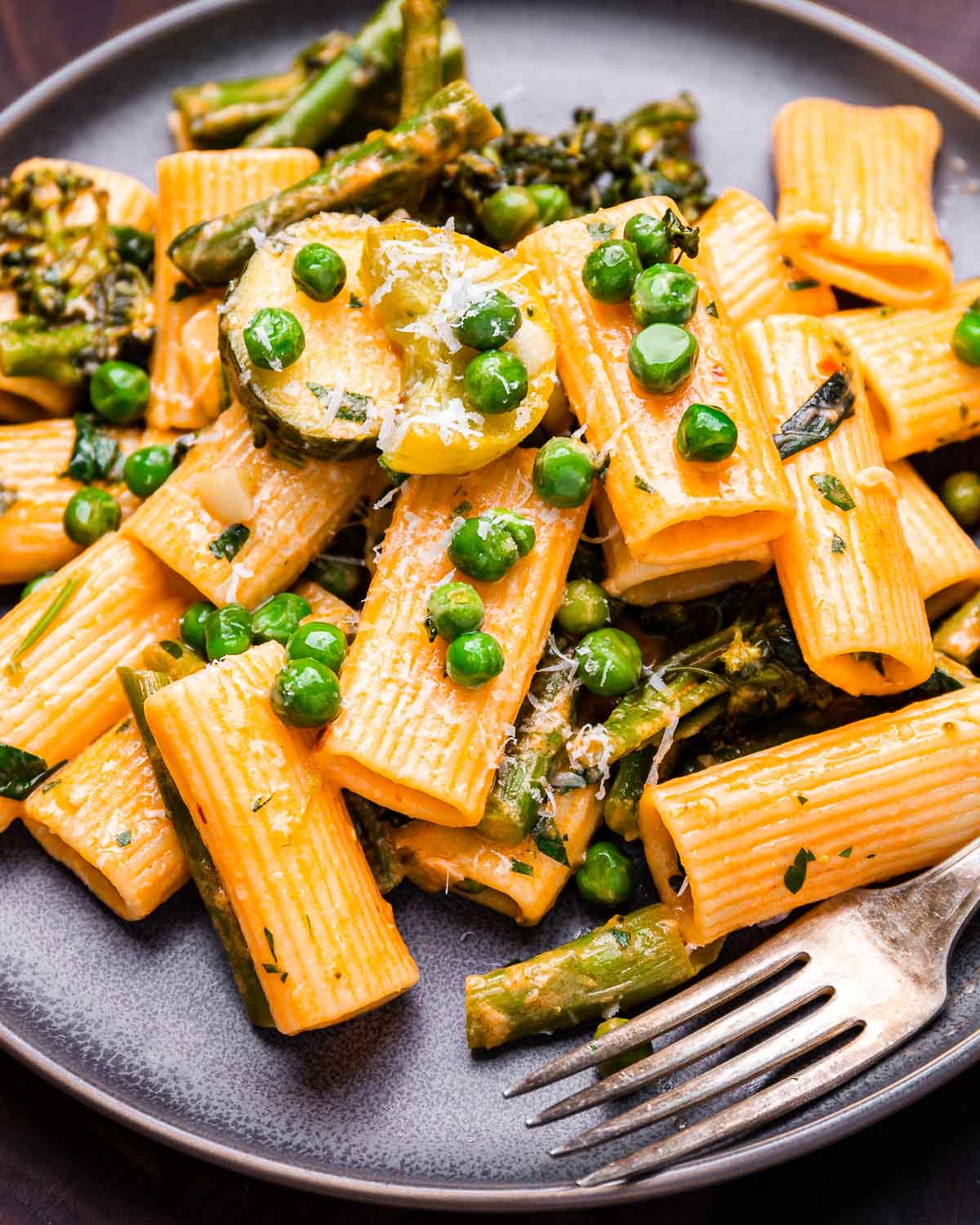
Walk into most Italian restaurants on Long Island, or the NY metro area, and you’ll find Pasta Primavera on the menu.
It’s usually made with garlic and oil, zucchini, carrots, broccoli, or other variety of veggies.
The problem with pasta primavera is that it’s usually pretty bland.
So we tampered a bit with the traditional recipe and made this rigatoni primavera a pasta to be reckoned with.
Using a sauce similar to alla vodka (minus the vodka) and the addition of broccolini and asparagus, we’ve unlocked a leveled-up version of primavera that we know you’ll love.
How to make it
Each number corresponds to the numbered written steps below.
Want To Save This Recipe?
- Trim 1 pound of asparagus by removing and discarding the bottoms, then cut into 2-inch pieces. Trim 1 pound of broccolini and cut into 2-inch pieces. Slice 1 medium zucchini and 1 medium yellow squash, and slice 6 cloves of garlic.
- Bring a large pot of salted water (2 tablespoons kosher salt per gallon of water) to boil. Heat a large pan to medium heat and 4 tablespoons of extra virgin olive oil and all the veggies except the peas. Note: if you’re using fresh peas, add them now as they’ll take a bit longer to cook than frozen peas.
- Saute for about 5 minutes, then add the peas and cook for 3 more minutes.
- Next, add the 6 cloves of sliced garlic and if the pan is dry, add a touch more olive oil and cook for another 1-2 minutes or until the garlic turns golden. Add 1/4 teaspoon of crushed red pepper flakes and season the veggies with salt. Transfer the veggies to a plate and set them aside.
- At this point, your water should be boiling and you can add the pasta and cook for 1 minute less than al dente. Turn the pan you used for your veggies to medium-low and add the remaining olive oil along with 2 tablespoons of tomato paste and cook the paste for 5 minutes, stirring frequently.
- Add 1 cup of dry white wine and turn the heat to high. Using a wooden spoon, scrape the pan to dislodge the brown bits.
- Once the wine reduces by half (about 2 minutes), turn the heat down to medium and add 1/2 cup of heavy cream. Mix well and bring to a simmer.
- Add 1 cup of pasta water to thin out the sauce and continue to cook over a low simmer.
- Add the pasta to the sauce along with 1/2 the veggies and toss to coat. If the sauce is too dry, add more of the reserved pasta water a little at a time to get the consistency just right.
- Cook the pasta in the pan until it reaches al dente (about 30-60 seconds), then remove the pan from the heat. Add 1/2 cup of grated Parmigiano Reggiano cheese and season with salt and pepper to taste.
- Add 1/4 cup of minced fresh Italian flat-leaf parsley, and 1/4 cup of hand-torn basil leaves and mix once more. If the pasta is dry, add some more reserved pasta water a bit at a time to loosen it up.
- To plate, add some of the pasta and veggie mixture to a pasta bowl or plate, then top with some of the remaining veggies. Serve with more grated cheese and enjoy!
Top tips for perfect rigatoni primavera
- The pasta water. This tip is listed first because it’s that important. Since there is cream in this sauce, it’s essential that you reserve some of your starchy pasta water to loosen up and reconstitute the sauce. Besides, it’s always a good rule of thumb to reserve pasta water when making any pasta dish. Add a little at a time until you achieve the perfect consistency.
- The veggies. We think the combination used here is the most interesting combination that yields maximum flavor and texture. We used zucchini, asparagus, broccolini, yellow squash, and green peas. If you prefer to use other veggie combos feel free to do so! If you opt to use fresh English peas as opposed to frozen peas, please note that they’ll likely need a bit longer to cook and soften up. If using the fresh peas, add those at the start along with the other veggies.
- The wine. We’re often asked about non-alcoholic substitutes for wine. In this case, you can use veggie stock, or even water to replace the cup of wine. If you are using wine, opt for a dry white wine.
More warm-weather pasta favorites!
We eat pasta year-round in our house, but in the warmer months, we (sometimes) opt for lighter pastas with sauces that don’t require hours of cooking. Here are a few of our absolute favorites!
- Lemon asparagus pasta – sliced asparagus tossed with lemon, garlic, and linguine.
- Lemon arugula pasta – Fresh lemon zest, baby arugula, and shaved Parmigiano Reggiano.
- Roasted cherry tomato pasta – Super easy pasta with roasted cherry tomatoes and garlic.
- Spaghetti alla Nerano – With thinly sliced zucchini, butter, and cheese.
- Pasta alla Norma – Roasted eggplant, tomatoes, basil, and ricotta salata.
- Roasted zucchini pasta – Bite sized roasted zucchini pieces tossed with ziti in a spicy marinara with smoked mozzarella.
If you’ve enjoyed this rigatoni primavera recipe or any recipe on this site, give it a 5-star rating and leave a review.
We strive to satisfy a number of learning styles. If you are someone who prefers to learn by watching, you can find most of our recipes on YouTube and our Facebook Page.
Rigatoni Primavera
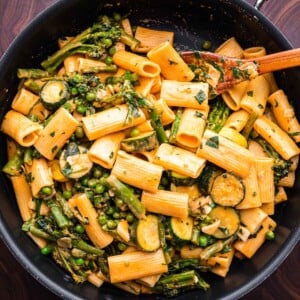
Ingredients
- 1 pound rigatoni
- 6 tablespoons extra virgin olive oil divided
- 6 cloves garlic sliced
- 1 pound broccolini cut into 2-inch pieces
- 1 medium zucchini sliced
- 1 medium yellow squash sliced
- 1 pound asparagus bottom trimmed and discarded, cut into 2-inch pieces
- 1 1/2 cups frozen peas see note below if using fresh English peas
- 1/4 teaspoon crushed hot red pepper flakes
- 2 tablespoon tomato paste
- 1 cup dry white wine
- 1/2 cup heavy cream
- 2 cups reserved pasta water will most likely not need all of it
- 1/2 cup grated Parmigiano Reggiano plus more for serving
- 1/4 cup minced Italian flat leaf parsley
- 1/4 cup basil leaves
Want To Save This Recipe?
Instructions
- Bring a large pot of salted water (2 tablespoons kosher salt per gallon of water) to boil.
- Heat a large pan to medium heat. Add 4 tablespoons of extra virgin olive oil and all of the veggies except for the peas. Saute for about 5 minutes then add the peas and cook for 3 more minutes.
- Next, add the garlic, and if the pan is dry add a touch more olive oil and cook for another 1-2 minutes or until the garlic turns golden. Add the hot red pepper flakes and season the veggies with salt. Transfer the veggies to a plate and set them aside.
- At this time begin boiling the pasta to 1 minute less than al dente.
- Turn the heat to medium-low and add the remaining olive oil to the pan along with the tomato paste. Cook the paste for 5 minutes, stirring frequently, then add the wine. Turn heat to medium-high and with a wooden spoon dislodge all of the brown bits.
- Once the wine reduces by half (about 2 minutes) turn the heat down to medium and add the cream. Mix well and bring to a simmer. Add 1 cup of pasta water to thin out the sauce and continue to cook over a low simmer.
- Add the pasta to the sauce along with 1/2 of the veggies. Toss to coat. If the sauce is too dry, add more of the reserved pasta water a bit at a time to get the consistency just right.
- Cook the pasta until it reaches al dente (about 30-60 seconds) then turn off the heat and remove the pan from the heat. Add the cheese and season with salt and pepper to taste. Add the parsley and basil and mix once more. If the pasta is at all dry add extra reserved pasta water, a bit at a time to loosen it up. Plate and top each with the remaining veggies. Serve with more grated cheese. Enjoy!
Notes
- Always reserve pasta water. If the pasta dries out before serving, just add a few ounces of the pasta water to bring the consistency back to perfect.
- Fresh English peas might need a bit more cooking to soften up than frozen peas. If using fresh peas they can be cooked right from the start with the other veggies.
- Leftovers can be saved for up to 3 days in the fridge. Reheat in the microwave.
Nutrition
Nutrition information is automatically calculated, so should only be used as an approximation.
Follow Me
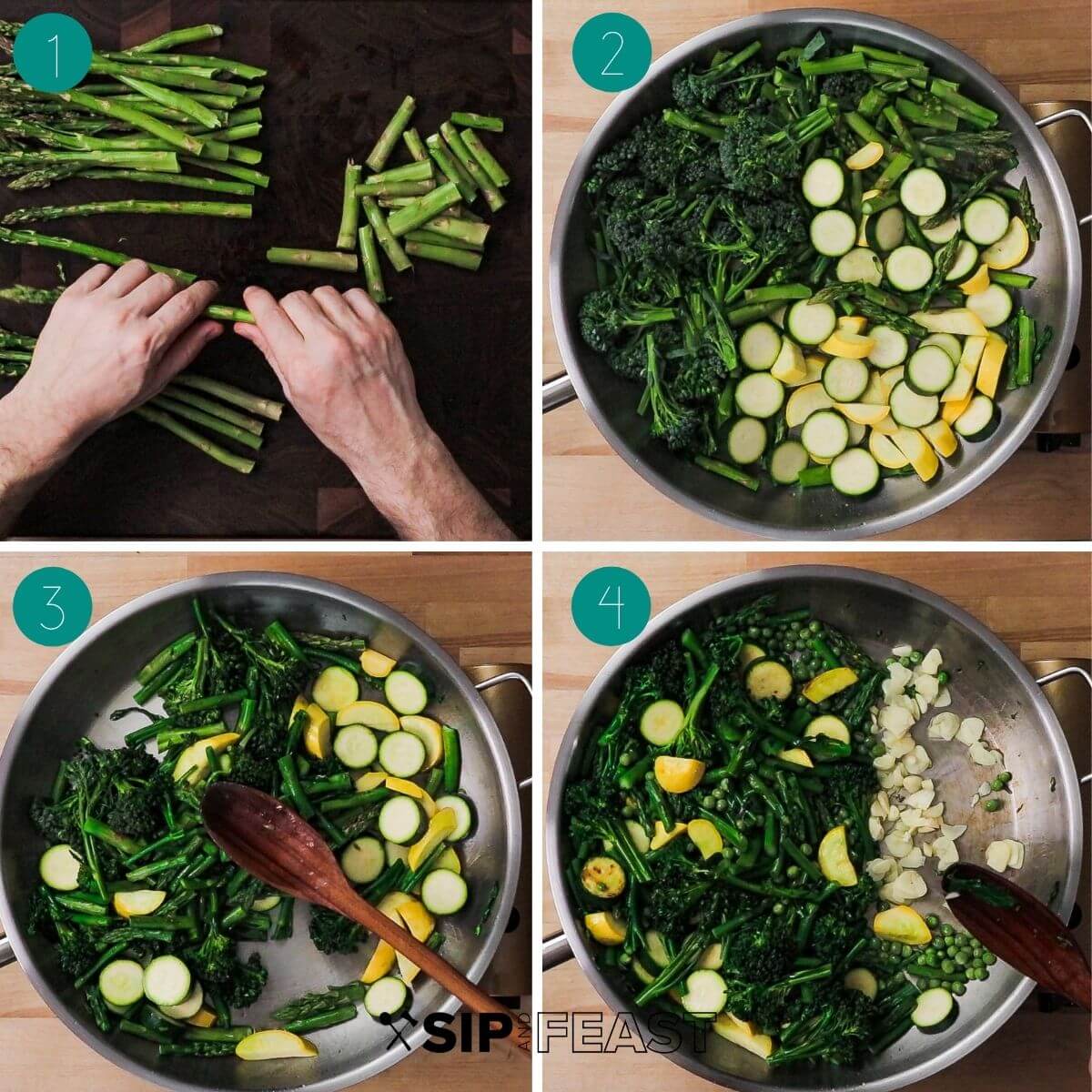
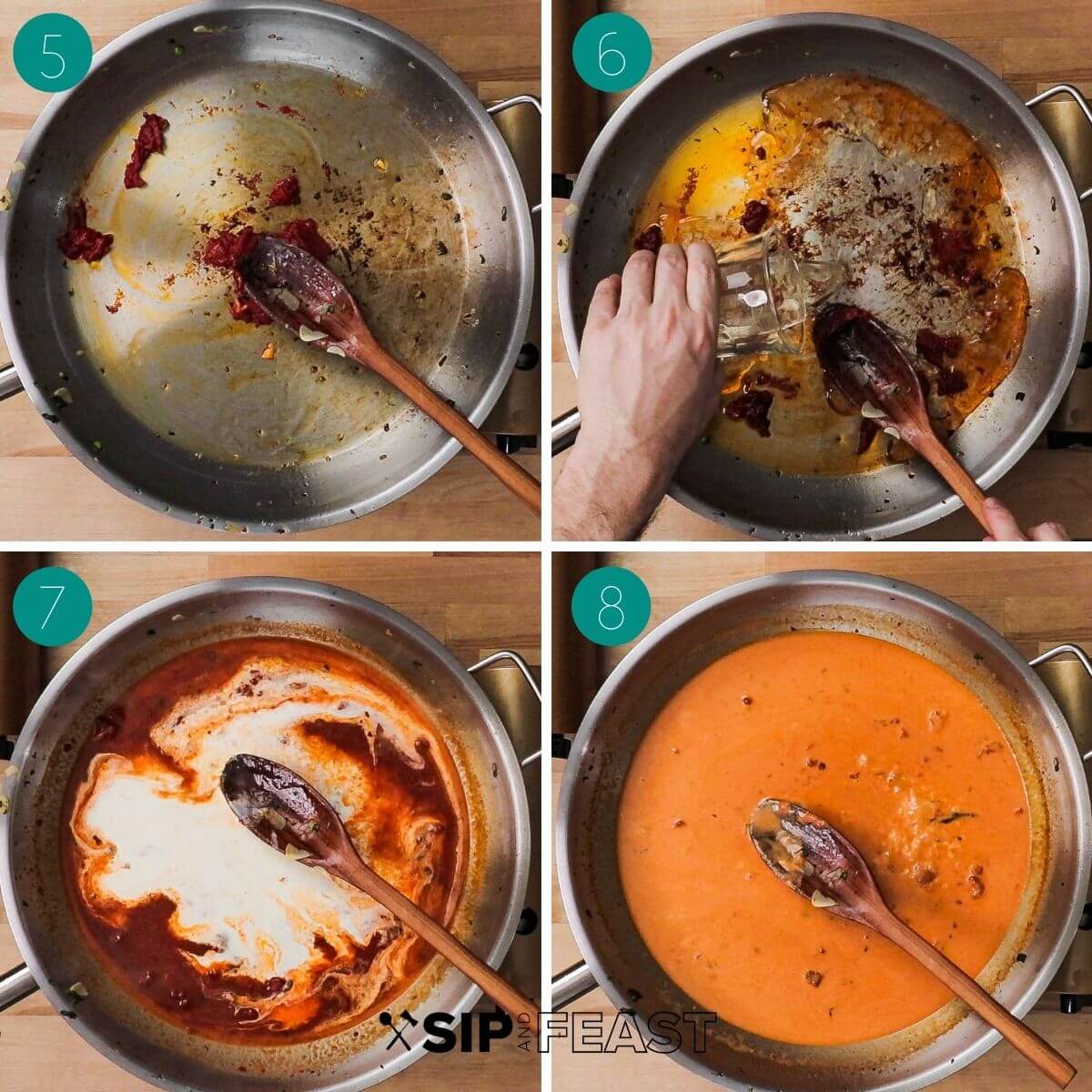
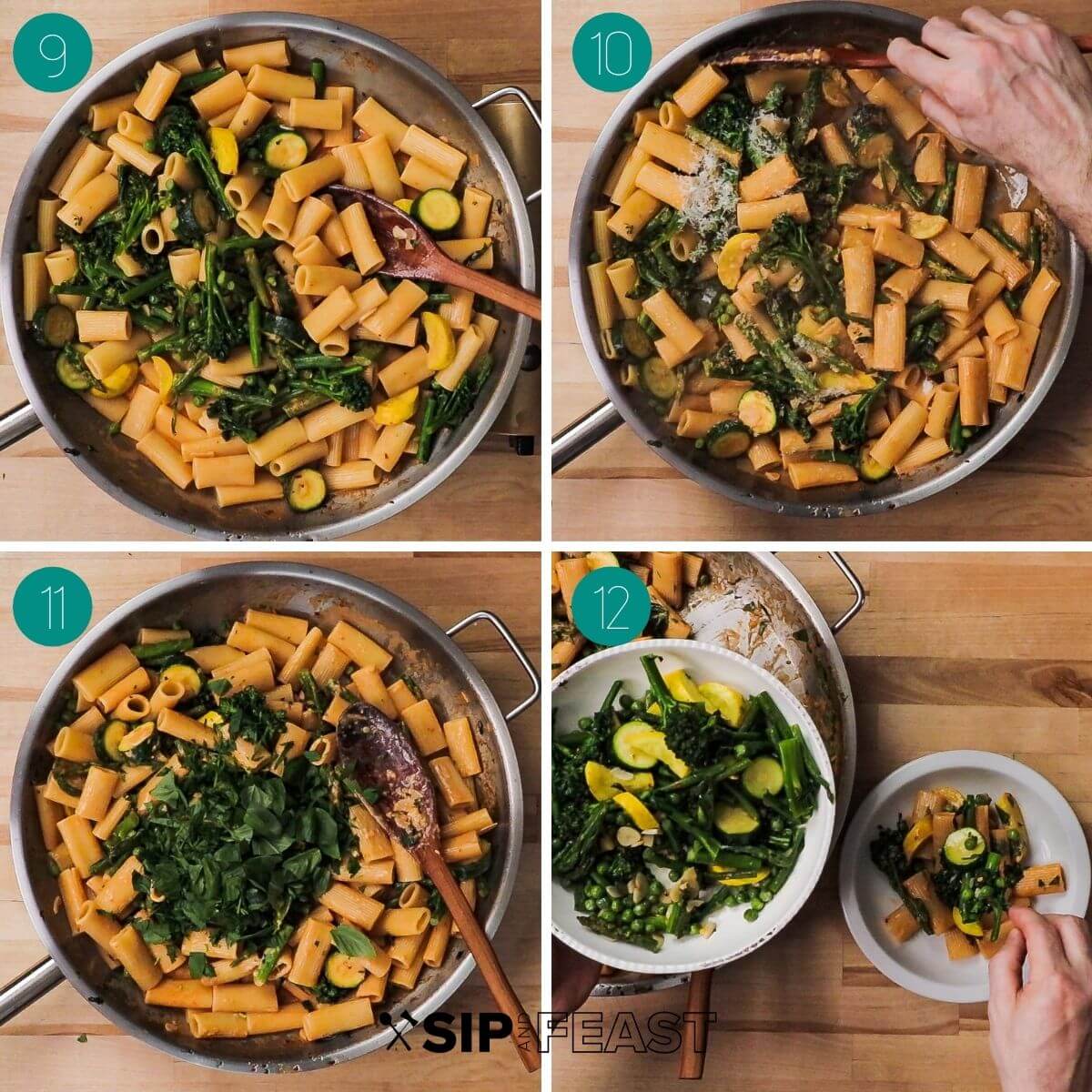
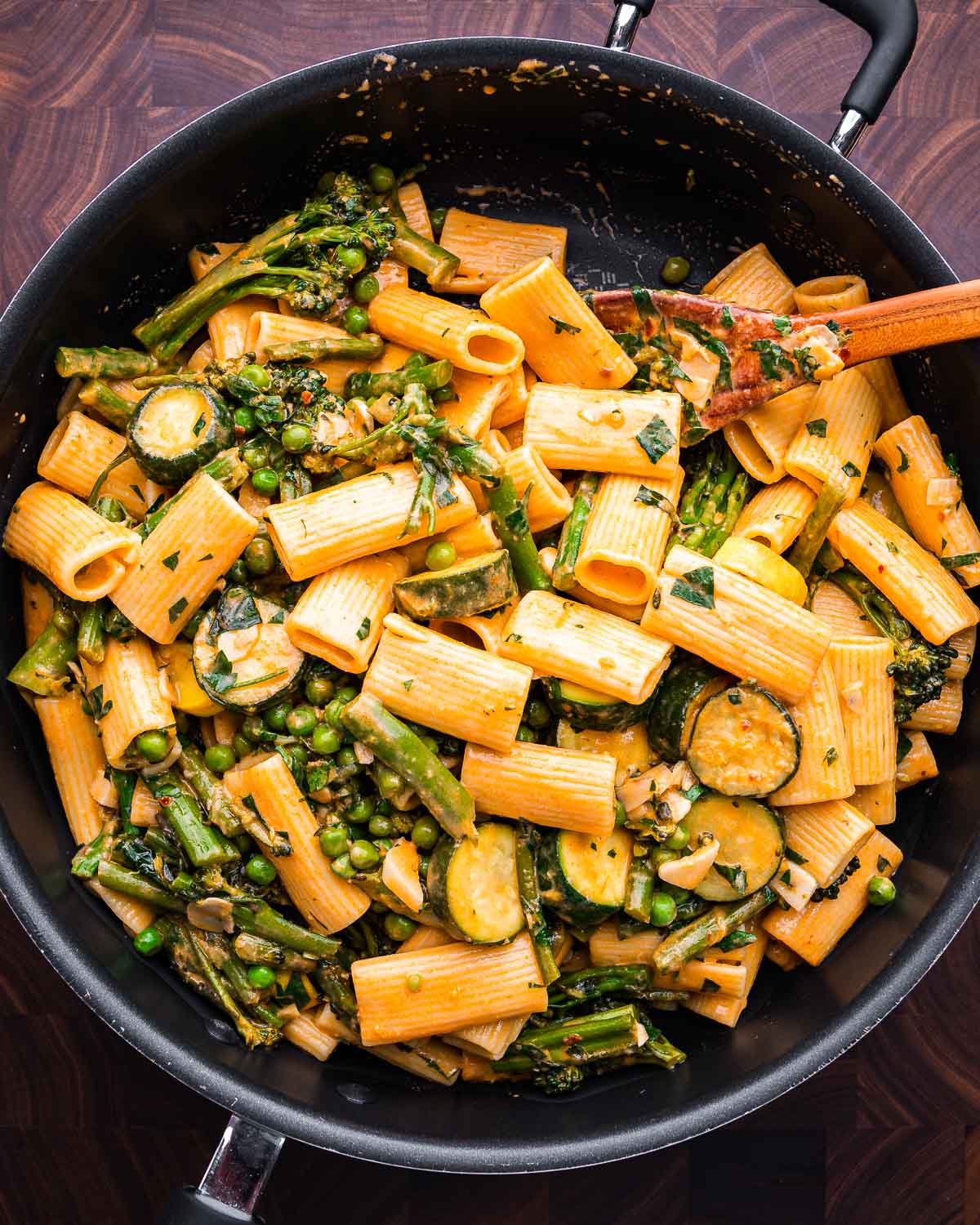







Can’t wait to try! Is there a video for this on the YouTube channel? I did tea and look for it and couldn’t find it. Love you guys, and you have so much great content, but sometimes can be tricky navigating it all.😊
PS – I know you have a lot going on… but hope at some point the podcast will be back-Obviously needs to make sense for you!
Hi Pam, yes, there is a video for this one – you can find it within the recipe card here in the recipe if you can’t find it on YouTube. Thanks for the kind and encouraging words!
I have a huge surplus of zucchini in my garden and made this recipe the other night. My favorite part was the sauce which was so light and delicious. I will be making this often to use the veggies from my garden!
We’re so happy you loved this recipe, Lynn!
Great recipe! So fresh and full of spring. I didn’t use any wine and I swapped out sour cream for heavy cream cuz that’s what I had on hand. It still tasted amazing. Thanks Jim.
Excellent recipe, thank you!
Hi Heena, thanks for the comment and so happy you enjoyed!
This is a very delicious and simple to make recipe. Great combination of veggies for pasta. Love it. Thanks again for another great recipe.
Hi Joyce, I’m so happy you liked this one too and thank you for the rating and comment!
I LOVE this recipe! I’ve made it a couple of times for vegetarian friends and they LOVED it too! It’s easy to follow and soooo tasty.
Hi Karla, thanks for the comment and so happy you enjoyed!
Nice take on this! Can’t wait for Spring again…
Hi Bruce, thanks for the comment and happy you liked the recipe!
hi! any substitute if you don”t drink alcohol?
Hi there, you can just omit the wine entirely and use more pasta water if you need more liquid.
Jim, this is one of the best pastas I’ve ever had. Love the healthy veggies. The cream sauce is absolutely killer. I’ve made it twice in two weeks. Kicker is the super easy prep and cleanup. Bravo
Hi Victor, I’m so happy to hear you like this one! Thanks for the comment!
Hello! I just discovered your recipes via YouTube last week-end and made this one for Saturday evening.It was light and delicious, and we had plenty of leftovers to enjoy during the week. Thank you for this recipe!
Hi Dora, thank you for the comment and so happy you’re enjoying the videos and recipes!
This was my first time trying pasta primavera, and I really enjoyed this recipe. Probably the only changes I would make is to add more sauce. By no means was the pasta dry at all despite using more veggies than you did, but I generally like pastas that are a bit saucier, so I would increase the tomato paste, white wine, cream etc. Other than that I thought it was a fantastic introduction to the dish and your presentation is excellent also. Keep up the good work !
Hey Joseph. Glad you enjoyed the flavor. I always try to stress to make these your own and I think making it saucier is a great idea. In a pinch, you could add more pasta water to thin it out at the end too. Thanks for the comment!
Alright so I’ve just tried making this same recipe again, doubling the cream and adding a bit more tomato paste and wine, and I have to say your original recipe is great the way it is and I was definitely mistaken! The pasta is definitely creamier, but in terms of taste I think the extra cream really weighs everything down and drowns the vegetables, which kind of ruins the whole point of a light and fresh springtime primavera. I take back what I said in my previous comment! Your original recipe gives enough sauce to flavour the vegetables nicely, but not so much that it takes away from them as the star of the show. I’ll be doing it your way from now on.
Hi Joseph, thanks for letting me know!
You are making me a much better cook
So happy I found your YouTube spot .
Thanks for all your recipes hmmmmm so so good . Your a great cook ,Chef
I hope you and your family stay as nice and humble as you are .
I really enjoy all your recipes I want to make them all just the way you do .
Thanks again Bon appétit
Hi Lorraine, thank you so much for your kind words and so happy you’re enjoying the recipes!